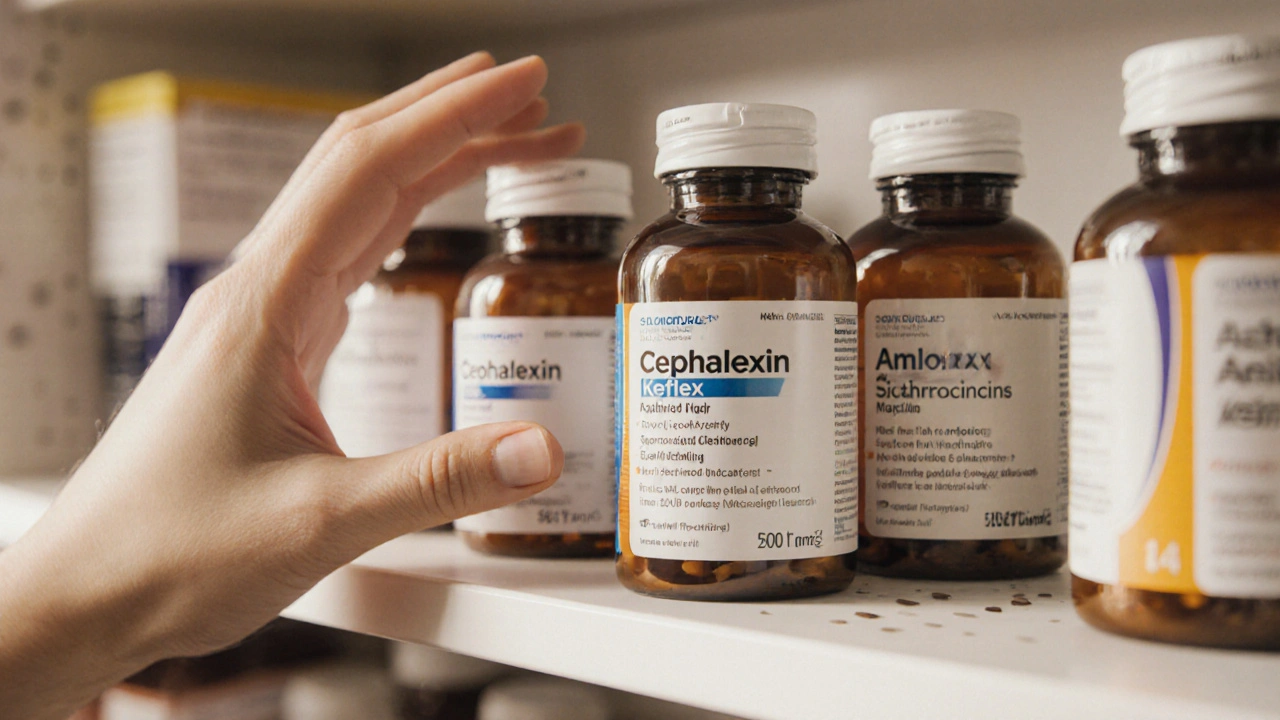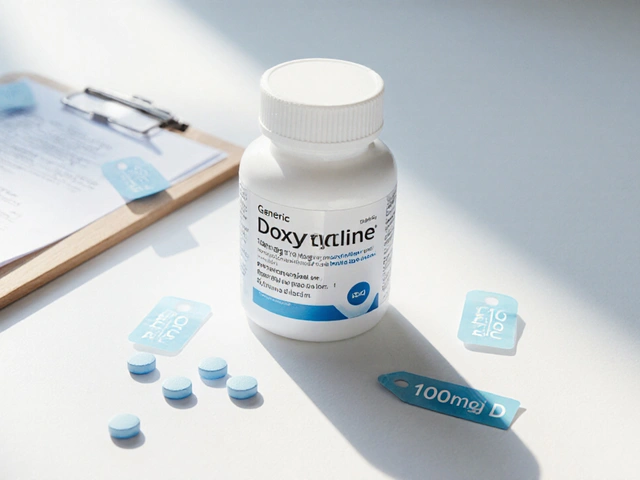
Quick Takeaways
- Cephalexin (Keflex) is a first‑generation cephalosporin effective for skin, bone and urinary infections.
- Amoxicillin offers a broader gram‑positive coverage but is weaker against some resistant staphylococci.
- Azithromycin is a once‑daily macrolide useful for patients who need a short course.
- Doxycycline works well for atypical pathogens and tick‑borne diseases, but can cause photosensitivity.
- Clindamycin is a good option for penicillin‑allergic patients with resistant skin infections, though it carries a higher risk of C.difficile.
When a doctor prescribes an antibiotic, patients often wonder whether Keflex (generic name Cephalexin is a first‑generation cephalosporin used for mild to moderate bacterial infections) is the best choice. The answer depends on the infection type, safety profile, dosing convenience, and cost. Below we compare Cephalexin with the most common oral alternatives and give you a practical decision‑making framework.
Cephalosporins are a class of beta‑lactam antibiotics that share a core structure with penicillins but have a slightly different side‑chain, giving them a broader spectrum against gram‑negative organisms.
Penicillins are the original beta‑lactam antibiotics, effective mainly against gram‑positive bacteria but increasingly challenged by resistance.
Methicillin‑resistant Staphylococcus aureus (MRSA) is a strain of Staph aureus that does not respond to many beta‑lactam antibiotics, including most cephalosporins.
How Cephalexin Works
Cephalexin interferes with bacterial cell‑wall synthesis by binding to penicillin‑binding proteins. This action is bactericidal, meaning it kills the bacteria rather than merely stopping their growth. Its spectrum covers many gram‑positive organisms (Staphylococcus aureus, Streptococcus pyogenes) and some gram‑negative rods (Escherichia coli, Proteus mirabilis). The drug is absorbed well orally, reaching peak plasma levels in about one hour, and is excreted unchanged in the urine.
Typical adult dosing is 250mg to 1g every 6-12hours, depending on infection severity. Treatment courses range from 5days for uncomplicated skin infections to 14days for bone infections. Common side effects include mild gastrointestinal upset, rash, and, rarely, allergic reactions that resemble penicillin allergy.
Key Comparison Criteria
To weigh Cephalexin against other drugs we look at five practical dimensions:
- Spectrum of activity - which bacteria are reliably killed.
- Dosing convenience - number of pills per day and food restrictions.
- Safety & tolerance - side‑effect profile, pregnancy category, and drug interactions.
- Resistance risk - likelihood of treatment failure due to local resistance patterns.
- Cost & availability - price per standard course in the UK.
Side‑by‑Side Comparison Table
| Antibiotic | Spectrum | Typical Dose (Adult) | Dosing Frequency | Pregnancy Safety | Common Side Effects | Average Cost (per 7‑day course) |
|---|---|---|---|---|---|---|
| Cephalexin | Gram‑positive + limited gram‑negative | 500mg | Every 6h | Category B | GI upset, rash | £2.50 |
| Amoxicillin | Broad gram‑positive, some gram‑negative | 500mg | Every 8h | Category B | Diarrhea, allergy | £1.80 |
| Azithromycin | Gram‑positive, atypical, some gram‑negative | 500mg | Once daily (5‑day pack) | Category B | GI upset, QT prolongation | £5.20 |
| Doxycycline | Atypical, gram‑positive, gram‑negative | 100mg | Twice daily | Category D (avoid 1st trimester) | Photosensitivity, esophagitis | £3.90 |
| Clindamycin | Gram‑positive, anaerobes, MRSA (some strains) | 300mg | Every 6h | Category B | C.difficile risk, taste | £7.40 |
Alternative #1 - Amoxicillin
Amoxicillin is a penicillin‑type antibiotic that blocks cell‑wall synthesis similarly to cephalosporins. It covers a wider range of gram‑negative bacteria, making it a go‑to for ear, sinus and mild urinary infections. However, its activity against Staphylococcus aureus is modest, so skin infections caused by resistant strains may need a different drug.
Pros: inexpensive, twice‑daily dosing, well‑studied safety in pregnancy. Cons: increasing resistance among common respiratory pathogens, not ideal for MRSA‑suspected cases.
Alternative #2 - Azithromycin
Azithromycin belongs to the macrolide class. It binds to the bacterial 50S ribosomal subunit, halting protein synthesis. The drug’s long half‑life allows a convenient 5‑day regimen-often a single 500mg dose on day1 followed by 250mg daily.
Pros: excellent for patients who forget doses, covers atypical organisms (Mycoplasma, Chlamydia) and certain gram‑negative bacteria. Cons: higher cost, potential for QT‑interval prolongation, and higher rates of resistance in Streptococcus pneumoniae.
Alternative #3 - Doxycycline
Doxycycline is a tetracycline derivative that inhibits bacterial protein synthesis. It is favored for tick‑borne illnesses, acne, and some respiratory infections where atypical bacteria are suspected.
Pros: broad spectrum, anti‑inflammatory properties useful in acne. Cons: can cause photosensitivity (sunburn risk), must be taken with plenty of water, not first‑choice in pregnancy.
Alternative #4 - Clindamycin
Clindamycin is a lincosamide that also blocks protein synthesis. It penetrates bone and skin well, making it valuable for deep‑tissue infections and for patients allergic to penicillins.
Pros: strong activity against MRSA and anaerobes, good bone penetration. Cons: significant risk of Clostridioides difficile colitis, taste alteration, more expensive.
When to Choose Cephalexin Over the Others
Cephalexin shines in these scenarios:
- Uncomplicated skin or soft‑tissue infections caused by Staphylococcus aureus (non‑MRSA) or Streptococci.
- Simple urinary tract infections where the pathogen is known to be susceptible.
- Patients who need a low‑cost option and can adhere to four‑times‑daily dosing.
- Pregnant women in their first two trimesters, where Category B status offers reassurance.
If the infection involves atypical bacteria, requires a short‑course regimen, or the patient has a history of penicillin allergy, one of the alternatives may be a better fit.

Practical Decision Tree
- Identify infection type (skin, respiratory, urinary, atypical).
- Check local resistance data (UK NHS reports 2024 show rising macrolide resistance).
- Assess patient factors: allergy to beta‑lactams, pregnancy, renal function.
- Match the antibiotic that covers the pathogen, fits dosing convenience, and stays within budget.
- Re‑evaluate after 48-72hours - if no improvement, consider culture‑guided switch.
Pitfalls to Avoid
- Prescribing Cephalexin for suspected MRSA without susceptibility data - risk of failure.
- Skipping the full course because symptoms improve - may foster resistance.
- Combining Cephalexin with oral contraceptives without counseling - although the interaction is rare, patients appreciate the heads‑up.
- Using high‑dose Cephalexin in patients with severe renal impairment - dose adjustment is needed.
Key Takeaway Checklist
- Cephalexin = first‑gen cephalosporin, best for uncomplicated skin/UTI.
- Amoxicillin = broader gram‑negative, cheap, but less MRSA coverage.
- Azithromycin = short course, good for atypicals, higher cost.
- Doxycycline = excellent for tick‑borne, photosensitivity risk.
- Clindamycin = strong for MRSA/all anaerobes, watch for C.difficile.
Frequently Asked Questions
Can I take Cephalexin if I’m allergic to penicillin?
Cephalexin is a cephalosporin, which is chemically related to penicillin. About 5‑10% of people who react to penicillin also react to cephalosporins. If you have a severe (anaphylactic) penicillin allergy, discuss alternatives with your doctor.
How long does it take for Cephalexin to start working?
Blood levels peak within one hour after a dose, and most patients notice symptom improvement within 48-72hours, provided the bacteria are susceptible.
Is it safe to use Cephalexin while breastfeeding?
Cephalexin passes into breast milk in small amounts and is generally considered compatible with breastfeeding. Monitor the infant for any rash or diarrhea.
What should I do if I miss a dose of Cephalexin?
Take the missed dose as soon as you remember, unless it’s almost time for the next dose. In that case, skip the missed one and continue with the regular schedule-don’t double‑dose.
How does Cephalexin compare cost‑wise to the alternatives?
In the UK, a 7‑day course of generic Cephalexin costs around £2.50, making it cheaper than azithromycin (£5.20) or clindamycin (£7.40). Amoxicillin is the least expensive at about £1.80 per week.
14 Comments
Sunil Sharma
October 15 2025
Good point about cost – many patients overlook that a 7‑day course is just a few pounds. If you’re not sure about the organism, start with amoxicillin and switch once cultures return.
Abhimanyu Lala
October 16 2025
Cephalexin? Just a cheap backup, not a hero.
Richard Sucgang
October 17 2025
While the guide attempts a balanced overview it inadvertently simplifies the complex pharmacodynamics of β‑lactams.
The pharmacokinetic profile of cephalexin, with its short half‑life, mandates four daily doses which may impair adherence.
In contrast azithromycin’s long half‑life permits a five‑day regimen that aligns with modern patient‑centred care.
Moreover the resistance patterns in the United Kingdom have shifted, rendering cephalexin less reliable for community‑acquired skin infections.
The table omits regional susceptibility data which clinicians require for evidence‑based prescribing.
Cost considerations, though important, should not override microbiological adequacy.
The checklist correctly flags the necessity of avoiding cephalexin in suspected MRSA, yet the narrative fails to emphasise culture‑guided therapy.
Pregnancy safety is noted but the teratogenic risk of doxycycline is understated.
The recommendation to use clindamycin without a C. difficile risk assessment is concerning.
Renal dosing adjustments are mentioned but lack specific guidance for eGFR thresholds.
The decision‑tree could benefit from a flowchart visual rather than plain text.
Finally, the guide’s emphasis on oral agents neglects the occasional need for intravenous therapy in severe osteomyelitis.
Readers should interpret the cost figures as approximations, not absolute market prices.
In sum the article serves as a starter but requires deeper clinical nuance.
Future revisions should incorporate local antibiogram statistics.
Russell Martin
October 18 2025
Bottom line – pick the drug that kills the bug and fits the patient’s schedule. If cost is tight, cephalexin wins for simple skin infections, otherwise azithro saves trips to the pharmacy.
don hammond
October 19 2025
Sure, because nothing says “smart care” like a cheap pill you have to take every six hours 😂
Ben Rudolph
October 20 2025
You’re ignoring the ethical duty to prevent resistance by using the most appropriate spectrum.
Ian Banson
October 21 2025
Brit doctors should stop borrowing US antibiotic habits and stick to the NHS formulary where cephalexin remains the first line for uncomplicated cellulitis.
marcel lux
October 21 2025
While local guidelines are crucial, the data presented here aligns well with current NICE recommendations for first‑generation cephalosporins.
Charlotte Shurley
October 22 2025
Good to see evidence‑based practice highlighted.
Brian Latham
October 23 2025
Looks fine.
Barbara Todd
October 24 2025
The guide could have mentioned the impact of food on doxycycline absorption, which is an important detail for patients.
nica torres
October 25 2025
Exactly, reminding patients to take doxycycline with water and avoid dairy can prevent treatment failure and keep spirits high!
Jeremy Wolfe
October 26 2025
Team effort like this-mixing safety, cost and convenience-helps everyone choose the right antibiotic without drama.






Nidhi Jaiswal
October 14 2025
Cephalexin is great for simple skin or urinary infections where the bug is known to be sensitive. It is cheap and safe in early pregnancy but avoid it if you have a severe penicillin allergy.